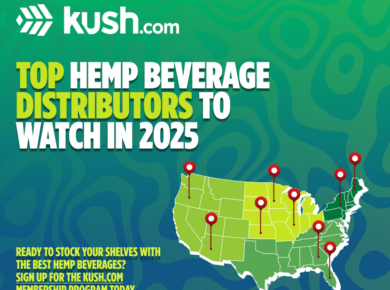Nanoemulsion, or nano-emulsion, is an advanced mode of delivery system for common additives that are typically oil based. There are many advantages to nanoemulsion, including:
- Use as a substitute for liposomes and vesicles
- Improves bioavailability of CBD
- Is non-toxic and non-irritant in nature
- Has improved physical stability
- Provides greater absorption
- Can be formulated for liquids, foams, creams and sprays
- Provides better uptake of oil-soluble supplements in cell culture technology
- Reduces flavor of additive or drug
- Requires less energy to dissolve
- Has fast-acting effects
Vana Labs, a partner of Kush.com, produces nanoemulsified CBD for its superior bioavailability, fast-acting effects, and potency to the process. Vana Labs has devoted four years to research and technological innovation to develop their proprietary nanoemulsion methodology.
Nanoemulsion is the key factor that sets their products apart from the competition, and through this technique, they have created water soluble CBD unlike anything on the market today. Products utilizing nanoemulsified CBD have many advantages over common oils.
Searching for Nano CBD? Find it on Kush.com >>
Nanoemulsion Defined
Nanoemulsion involves two key factors: tiny CBD nanoparticles, which are so small that they are measured in nanometers (one-billionth of a meter), and an emulsifier: a substance into which these CBD nanoparticles are dispersed.
Though nanoemulsion is a relatively complicated process, for the purposes of this article, we can boil the process down to two crucial components. The first is nanotechnology, which is used to create microscopically small CBD nanoparticles; this prepares our CBD for the second step in nanoemulsion, which involves the addition of an emulsifier.
Nanotechnology and CBD Nanoparticles
The first step in nanoemulsion involves the use of nanotechnology, an innovative method of reducing CBD molecules to a microscopically small size. “Nano” is a prefix for “dwarf,” and denotes an extremely small item.
We create CBD nanoparticles using nanotechnology, which involves the use of ultrasonic waves to pressurize and shatter individual CBD molecules into dozens of exponentially smaller nanoparticles.
Emulsion can only occur if a substance has been reduced into tiny, “nano” droplets; thus our nanotechnology is crucial to creating nanoparticles small enough to emulsify.
Often, companies that attempt nanoemulsion do not have the advanced technology necessary to create a truly nanoemulsified product–this is a problem in the industry that Vana Labs has set out to correct. A true nanoemulsion requires nanoparticles that measure between five and two-hundred nanometers in diameter (one nanometer is one-billionth of a meter).
Such a small size may be difficult to conceptualize. As a point of comparison, consider that a single human hair is between eighty-thousand and one-hundred thousand nanometers wide.
CBD nanoparticles are exponentially smaller. In fact, you could fit–at the very least–four-thousand CBD nanoparticles across the width of a single human hair.
Emulsifiers
The second step in nanoemulsion involves the use of an emulsifier, an intermediary substance that forces two otherwise incompatible substances–such as water and oil–to mix. CBD is lipophilic, meaning that it dissolves in fat rather than water.
When CBD created without nanoemulsion is placed in water, it behaves like an oil; rather than dissolving, it separates into coagulated droplets that float on the surface of the liquid, rather than mixing with and disseminating through it.
CBD oil is not water-soluble, meaning that it cannot mix with water, but mixing the two is possible through nano-emulsion. This is a major problem, as water accounts for nearly 60% of the human body; the CBD it contains behaves like oil in water, refusing to mix into the bloodstream (which is necessary for CBD to produce its effects).
To solve this problem, Vana Labs places its CBD nanoparticles in an emulsifier, which serves as a base that forces the CBD it contains to mix with water (whether in the body, or in a beverage–hence the phrase “water soluble CBD”). Our emulsion process involves the use of fat and water, using an emulsifier that is both hydrophilic (water soluble) and lipophilic (fat soluble) at once.
When placed in fat, CBD nanoparticles dissolve, and their surfaces become coated in layers of fat. This protective coating allows CBD to dissolve before it is dispersed in the bloodstream, thus forcing CBD and water to mix.
The resulting product is water soluble, and unlike CBD oil, mixes easily with water–both in beverages and in the human body.
The Vana Labs Process: Redefining Nanoemulsion and Water Soluble CBD
CBD oils are far more common than nanoemulsified CBD, while very few companies offer water soluble CBD that has undergone true nanoemulsion. Yet CBD oils are, in a sense, counterintuitive: oil and water don’t mix, and neither do water and CBD, making it extremely difficult for the body to absorb any of the CBD in a dose of CBD oil.
Nanoemulsion requires extensive resources, specialized knowledge, and advanced technology to implement. Luckily, these are Vana Labs’ specialities. After four years of research and development, Vana Labs has developed a nanoemulsion technology unlike any other.
Combining advanced technology, dedicated resources, and scientific expertise, Vana Labs has mastered nanoemulsion at an unrivaled level of advancement.
Interested in Sourcing Nano Emulsified CBD or Other Material?
Shop nano-emulsified CBD on Kush.com or fill out the form below to get more information from Vana Labs.



